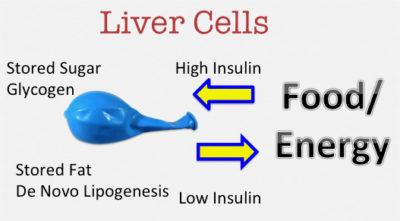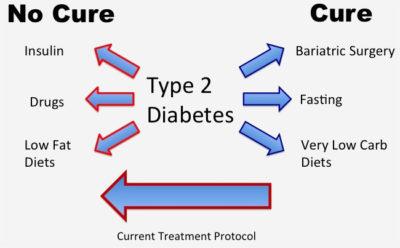
Over 50% of American adults are estimated to have prediabetes or diabetes. The twin cycles ( hepatic and pancreatic) are not simply rare metabolic mistakes leading to disease. These responses are almost universal because they serve as protective mechanisms.
Protective? I can almost hear you gasp. Insulin resistance and beta cell dysfunction are protective? Yes. Absolutely. What do they protect us from? The very name gives use the vital clue. Insulin resistance protects the liver from too much insulin. Our body is resisting the excessive insulin, which is harmful.

When insulin levels stay elevated for a prolonged period, the liver fills up with sugar and fat, like an over-inflated balloon. The pressure inside the liver goes up and up, making it increasingly difficult to move sugar into this overfilled liver. This is insulin resistance. The liver simply cannot store any, so rejects the incoming sugars, becoming resistant to insulin's normal signal. Glucose piles up outside the cell in the blood.
This provokes a compensatory hyperinsulinemia. Like trying to inflate the over-inflated balloon, it works for a time. However, it becomes more and more difficult.

The liver is busy trying to clear the fatty congestion by exporting this new fat. Some of it accumulates in the pancreas, eventually clogging it and lowering insulin levels. This is exactly the correct protective response. As high insulin is the very problem that causes type 2 diabetes, reducing insulin is the most effective protective strategy.
Blood glucose surges to abnormally high levels and spills out into the urine causing many of the symptoms of frequent urination and thirst. This too can be understood as an appropriate, protective mechanism. Forcing more glucose into the over-filled liver and pancreas will eventually destroy it. The body is now trying rid itself of the toxic glucose by eliminating it through the urine.
Obesity, too can be understood as a protective response against excessive de novo lipogenesis. Adipocytes are specialized cells that store fat (triglycerides) without problem. Without fat cells to store this newly created fat, it would otherwise immediately deposit in the organs and cause type 2 diabetes. In the rare genetic disease of the Beradinelli-Siep lipodystrophy syndrome, there is a congenital lack of fat cells. Virtually all of these patients develop type 2 diabetes, often by their teenage years, as excess fat from both diet and de novo lipogenesis deposit directly in the liver and muscles.
Long-standing fatty liver causes scarring and will soon become the leading cause of liver failure in North America. Long-standing fatty pancreas will eventually lead to scarring as well, and after many decades, the pancreas is destroyed. To protect itself, the body needs to rid itself of this excessive toxic glucose load. By forcing the glucose out into the blood, it will spill out in the urine. This causes many of the symptoms of excessive urination and weight loss, but at least the toxic glucose load is being excreted.
Implications
This new understanding carries several important implications. First, type 2 diabetes results from a single underlying, unified mechanism. It does not result from two entirely separate pathophysiologic mechanisms, one for insulin resistance and another for beta cell dysfunction. The natural history and all of the manifestations of type 2 diabetes can be explained from excessive fatty organ infiltration.
Too much de novo lipogenesis results in fatty liver and insulin resistance. Too much fat in the beta cells results in lower insulin production. But hyperinsulinemia is ultimately the root cause of the entire problem.
Secondly, both defects of insulin resistance and the beta cell dysfunction are entirely reversible by removal of the excess fat clogging the organs. Contrary to popular belief, the pancreas is not scarred and burned out beyond repair. Instead, the pancreas is simply clogged with fat. Once you unclog the fat, the pancreas starts to work again and insulin is secreted normally.
Thirdly, and perhaps most importantly, type 2 diabetes is both preventable and reversible, not chronic and progressive. It is not a life sentence. This new dawn carries tremendous hope for those afflicted. We only need to understand the underlying disease and apply our new knowledge. Our treatments were ineffective, and so we believed progression was part of the natural history the disease itself. Instead, the culprit was our fundamental misinterpretation of this disease.
Towards a cure
In any disease, success depends upon identifying and treating the underlying cause, not the symptoms. For example, a bacterial infection may cause symptoms such as fever. The root cause is the bacterium and fever is only a symptom. To cure the disease, you must address the root cause, in this case, an antibiotic to kill the bacteria. This also successfully eliminates the symptom of fever.
But if you simply treat the symptom, there is no benefit. In this case, you can treat the fever with acetaminophen, but the infection persists unabated and may eventually kill you. Once you stop taking acetaminophen, the fever returns because the disease has not been treated. This may seem like the disease is chronic and progressive, but only because the treatment is incorrect. Treating the fever is only symptomatic treatment, since the fever is not the actual disease.
The exact same problem exists in type 2 diabetes. The root cause is hyperinsulinemia, and the symptom is high blood glucose. Type 2 diabetes, and indeed all the manifestations of the metabolic syndrome are diseases caused by too much insulin. Yet our current treatment paradigm focuses on lowering the blood glucose, which is only the symptom of the disease, but not the disease itself. Instead of treating the hyperinsulinemia, we were treating the high blood glucose.
The currently recommended treatments for type 2 diabetes include insulin, oral hypoglycemic drugs and low fat diets. Fifty years of experience tells us that these treatments do not cure the disease and only treat the symptoms. All these therapies are directed towards lowering blood sugar, but not the underlying hyperinsulinemia. In fact, all of these treatments raise insulin.

Here's comes the sudden, horrifying realization. The treatments we have been using for type 2 diabetes were EXACTLY wrong. Too much insulin causes this disease. Giving insulin or drugs that raise insulin will not make the disease better. It will only make it worse!
It is no different from treating alcoholism with more alcohol. Treating alcohol withdrawal by giving more alcohol will certainly improve symptoms in the short-term. But the disease, the alcoholism will get worse.
This is precisely what happened. Type 2 diabetic patients are generally started on one medication at diagnosis. This only treats the symptoms, so over time the disease gets worse, and the dose is increased. Once the maximum dose is reached, a second, then a third drug is added. After that, insulin is prescribed in ever increasing doses in a desperate bid to control the blood sugar.
But, if you require higher and higher doses of medications, your diabetes is not getter better, it is getting worse. The treatment was exactly wrong.
In type 2 diabetes insulin levels are high, not low. Injecting more insulin is not going to help treat it. Yes, in the short-term, the symptom of high blood sugar is better, but the disease, the diabetes was continually getting worse.
How did we expect that giving more insulin to a patient with too much already would help? Our standard accepted treatments were precisely how NOT to treat type 2 diabetes.
-
Jason Fung

